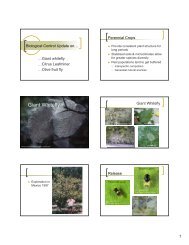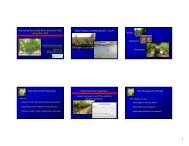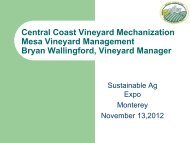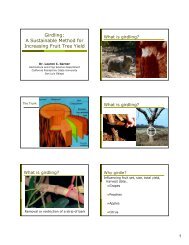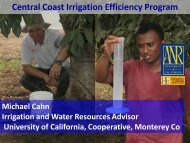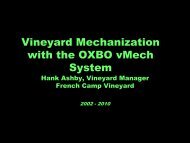The 5 P's of Sustainable Agriculture, Ecosystem-based IPM, and the ...
The 5 P's of Sustainable Agriculture, Ecosystem-based IPM, and the ...
The 5 P's of Sustainable Agriculture, Ecosystem-based IPM, and the ...
You also want an ePaper? Increase the reach of your titles
YUMPU automatically turns print PDFs into web optimized ePapers that Google loves.
S S U U S S T T A A I N I N A A B B I L I L I T I T Y Y F F R R O M T T H H E E G R R O U U N N D D U U PP<strong>The</strong> 5 P’s <strong>of</strong> <strong>Sustainable</strong> <strong>Agriculture</strong>,<strong>Ecosystem</strong>-<strong>based</strong> <strong>IPM</strong>, <strong>and</strong> <strong>the</strong> Role <strong>of</strong> <strong>the</strong><strong>IPM</strong> Pr<strong>of</strong>essional<strong>Sustainable</strong> Ag ExpoNovember 15, 2011Clifford P. Ohmart, PhDSureHarvest&Peter Goodell, PhDUniversity <strong>of</strong> CaliforniaStatewide <strong>IPM</strong> Program
Presentation OutlineS U S T A I N A B I L I T Y F R O M T H E G R O U N D U P• Challenges to Implementing <strong>Sustainable</strong> Ag & <strong>IPM</strong>• Defining <strong>Sustainable</strong> Ag & <strong>IPM</strong>• Meeting <strong>the</strong> Challenges - <strong>The</strong> 5 P’s <strong>of</strong> <strong>Sustainable</strong><strong>Agriculture</strong>• Pest Management Challenges & <strong>IPM</strong> Planning• What does an <strong>IPM</strong> Plan Look Like?• Resources for <strong>IPM</strong> Planning• <strong>The</strong> Role <strong>of</strong> <strong>the</strong> <strong>IPM</strong> Pr<strong>of</strong>essional
S U S T A I N A B I L I T Y F R O M T H E G R O U N D U PThree Challenges to Implementing<strong>Sustainable</strong> <strong>Agriculture</strong> & <strong>IPM</strong>1) Defining it:• How can I do it if I can’t define it?• What are <strong>the</strong> boundaries <strong>of</strong> <strong>the</strong> definition (<strong>Sustainable</strong> Ag)?• <strong>The</strong>re are no universally accepted st<strong>and</strong>ards2) Implementing it:• How do I practice it on my farm?• How do we extend this to an entire sector/region?3) Measuring it:• Tracking practices & performance – where am I at?• How is it impacting my farming operation/bottom line?
S U S T A I N A B I L I T Y F R O M T H E G R O U N D U PDefining <strong>Sustainable</strong> <strong>Agriculture</strong>Leaving …development <strong>the</strong> farm that in as meets goodor <strong>the</strong> better needs shape <strong>of</strong> <strong>the</strong> for present <strong>the</strong> nextgeneration without compromising than when one <strong>the</strong>started ability <strong>of</strong> farming future it. generationsto meet <strong>the</strong>ir own needs.- 1987 United Nation’sBrundtl<strong>and</strong> Commission
S U S T A I N A B I L I T Y F R O M T H E G R O U N D U PEnvironmentallySoundEconomicallyViableSociallyEquitable<strong>The</strong> three “E’s” <strong>of</strong> Sustainability
S U S T A I N A B I L I T Y F R O M T H E G R O U N D U PWhat is <strong>the</strong> definition <strong>of</strong> <strong>IPM</strong><strong>The</strong>re are many - I use this one:<strong>IPM</strong> is a sustainable approach to managingpests by combining biological, cultural <strong>and</strong>chemical tools in a way that minimizeseconomic, environmental <strong>and</strong> health risks.
S U S T A I N A B I L I T Y F R O M T H E G R O U N D U PWhat is <strong>IPM</strong>? (from UC <strong>IPM</strong> Website*)"<strong>IPM</strong>," is a process you can use to solve pest problems whileminimizing risks to people <strong>and</strong> <strong>the</strong> environment.How does it work?‣ Focuses on long-term prevention <strong>of</strong> pests or <strong>the</strong>irdamage by managing <strong>the</strong> ecosystem‣ Monitoring <strong>and</strong> correct pest identification‣ <strong>IPM</strong> programs combine management approaches forgreater effectiveness*www.ipm.ucdavis.edu
S U S T A I N A B I L I T Y F R O M T H E G R O U N D U P<strong>The</strong> 5 essential components <strong>of</strong> an <strong>IPM</strong> Program:1) Underst<strong>and</strong> crop ecology2) Underst<strong>and</strong> pest ecology (<strong>and</strong> naturalenemies)3) Monitoring for pests4) Use <strong>of</strong> economic thresholds5) Consider control options(<strong>based</strong> on minimizing economic,environmental <strong>and</strong> health risks)
S U S T A I N A B I L I T Y F R O M T H E G R O U N D U P<strong>Sustainable</strong> <strong>Agriculture</strong> (<strong>and</strong> <strong>IPM</strong>)is a ContinuumWhere does onedraw a line?Less <strong>Sustainable</strong> (or <strong>IPM</strong>)More <strong>Sustainable</strong> (or <strong>IPM</strong>)
S U S T A I N A B I L I T Y F R O M T H E G R O U N D U PThoughts to Consider About<strong>Sustainable</strong> Ag & <strong>IPM</strong>• <strong>The</strong>y are not recipes; <strong>the</strong>y are paradigms• <strong>The</strong>y are business models to apply to one’s farm• <strong>Sustainable</strong> agriculture is a journey, it is not adestination• <strong>Sustainable</strong> agriculture involves compromises• <strong>The</strong> world <strong>of</strong> sustainable agriculture is one where<strong>the</strong> horizon always seems to be receding!
S U S T A I N A B I L I T Y F R O M T H E G R O U N D U PSureHarvest’s Continuous Improvement Framework1. Principles: <strong>The</strong> values that define your strategy2. Processes: <strong>The</strong> set <strong>of</strong> managed activities that createinternal <strong>and</strong> external value (e.g. production, sales, etc.)3. Practices: <strong>The</strong> methods used to accomplish <strong>the</strong>desired operational results (e.g., irrigationmanagement best practices)4. Performance: <strong>The</strong> metrics <strong>and</strong> measurements usedto evaluate practice <strong>and</strong> process results5. Progress: <strong>The</strong> approach used to document,communicate <strong>and</strong> drive continuous improvement overtime (e.g. assessment, benchmarking, action plans,training, reporting, etc.)
S U S T A I N A B I L I T Y F R O M T H E G R O U N D U P5P’s in Action: Winegrape ExamplePrinciplesSell crop at a pr<strong>of</strong>itProduce highest quality crop possible <strong>and</strong> optimize yieldsAdopt model <strong>of</strong> continuous improvement for <strong>the</strong> farmDefine <strong>and</strong> DocumentProcessesDefine <strong>and</strong> DocumentIrrigation Management Nutrient Management Pest ManagementInstall flow meterTissue samplingMonitor for pestsPracticesMonitor for leaks <strong>and</strong>clogsImplementTest for distributionuniformityDevelop nutrientbudgetUse fertigationUse economicthresholdsUse reduced riskpesticidesPerformanceDetermine Metrics <strong>and</strong>Implement MeasuresWater use efficiencyOptimized yield <strong>and</strong> qualityNutrient use efficiencyLower crop loss,reduced pesticide risksProgressAssessment & reassessmentContinuousDefine <strong>and</strong> ImplementImplement Improvement ApproachimprovementsAction PlansBenchmarking
<strong>The</strong> 5 P’s <strong>of</strong> <strong>Sustainable</strong> Ag – Meeting <strong>the</strong> ChallengesPrinciples:Defining• Produce highest quality crop possible <strong>and</strong> optimize yields• Adopt model <strong>of</strong> continuous improvement for <strong>the</strong> farm• Use <strong>IPM</strong> to manage my pestsProcesses:IrrigationManagementNutritionManagementPestManagementSoilManagementImplementingPractices:Install flow MeterMonitor for leaks &clogsDeficit irrigationTissue samplesUse fertigationDetermine nutrientbudgetMonitor for pestsUse reduced riskpesticidesUse economicthresholdsMinimize tillageTake soil samplesMinimize erosionTest for distributionuniformityAdd compostCheck sprayercoveragePlant cover cropsPerformance:MeasuringProgress:Efficient water use,optimized yield <strong>and</strong>qualityImprovementsEfficient nutrientuse, optimized yield<strong>and</strong> qualitySelf -assessmentAction plansReduced pesticide risk,lower crop loss, improvedyield & qualityBenchmarkingQuality soil, reducederosion, good airquality
<strong>The</strong> 5 P’s <strong>of</strong> <strong>Sustainable</strong> Ag – where does <strong>IPM</strong> fit in?Principles:• Produce highest quality crop possible <strong>and</strong> optimize yields• Adopt model <strong>of</strong> continuous improvement for <strong>the</strong> farm• Use <strong>IPM</strong> to manage my pests<strong>IPM</strong>Processes:IrrigationManagementNutritionManagementPestManagementSoilManagementInstall flow MeterTissue samplesMonitor for pestsMinimize tillagePractices:Monitor for leaks &clogsDeficit irrigationUse fertigationDetermine nutrientbudgetUse reduced riskpesticidesUse economicthresholdsTake soil samplesMinimize erosionTest for distributionuniformityAdd compostCheck sprayercoveragePlant cover cropsPerformance:Efficient water use,optimized yield <strong>and</strong>qualityEfficient nutrientuse, optimized yield<strong>and</strong> qualityReduced pesticide risk,lower crop loss, improvedyield & qualityQuality soil, reducederosion, good airqualityProgress:Self -assessmentImprovementsAction plansBenchmarking
<strong>The</strong> 5 P’s <strong>of</strong> <strong>Sustainable</strong> Ag – Where does self-assessment fit in?Principles:• Produce highest quality crop possible <strong>and</strong> optimize yields• Adopt model <strong>of</strong> continuous improvement for <strong>the</strong> farm• Leave farm in great shape for next generationProcesses:IrrigationManagementNutritionManagementPestManagementSoilManagementInstall flow MeterTissue samplesMonitor for pestsMinimize tillagePractice-<strong>based</strong> selfassessment toolse.g. Positive PointSystem, LodiWorkbook, CSWAWorkbookPractices:Monitor for leaks &clogsDeficit irrigationTest for distributionuniformityUse fertigationDetermine nutrientbudgetAdd compostUse reduced riskpesticidesUse economicthresholdsCheck sprayercoverageTake soil samplesMinimize erosionPlant cover cropsPerformance:Progress:Self -assessmentImprovementsAction plansBenchmarking
<strong>The</strong> 5 P’s <strong>of</strong> <strong>Sustainable</strong> Ag – Where does certification fit in?Principles:• Produce highest quality crop possible <strong>and</strong> optimize yields• Adopt model <strong>of</strong> continuous improvement for <strong>the</strong> farm• Leave farm in great shape for next generationProcesses:IrrigationManagementNutritionManagementPestManagementSoilManagementInstall flow MeterTissue samplesMonitor for pestsMinimize tillagePractice-<strong>based</strong>certificatione.g. SIP, Lodi Rules,Organic,BiodynamicPractices:Monitor for leaks &clogsDeficit irrigationUse fertigationDetermine nutrientbudgetUse reduced riskpesticidesUse economicthresholdsTake soil samplesMinimize erosionTest for distributionuniformityAdd compostCheck sprayercoveragePlant cover cropsPerformance:Progress:Self -assessmentImprovementsAction plansBenchmarking
<strong>The</strong> 5 P’s <strong>of</strong> <strong>Sustainable</strong> Ag – Where CCSWP certification fit in?Principles:• Produce highest quality crop possible <strong>and</strong> optimize yields• Adopt model <strong>of</strong> continuous improvement for <strong>the</strong> farm• Leave farm in great shape for next generationProcesses:IrrigationManagementNutritionManagementPestManagementSoilManagementInstall flow MeterTissue samplesMonitor for pestsMinimize tillagePractices:Monitor for leaks &clogsDeficit irrigationUse fertigationDetermine nutrientbudgetUse reduced riskpesticidesUse economicthresholdsTake soil samplesMinimize erosionTest for distributionuniformityAdd compostCheck sprayercoveragePlant cover cropsPerformance:Progress:Self -assessmentImprovementsAction plansBenchmarking
Performance <strong>based</strong> self-assessmentPrinciples:• Produce highest quality crop possible <strong>and</strong> optimize yields• Adopt model <strong>of</strong> continuous improvement for <strong>the</strong> farm• Leave farm in great shape for next generationProcesses:IrrigationManagementNutritionManagementPestManagementSoilManagementInstall flow MeterTissue samplesMonitor for pestsMinimize tillagePractices:Monitor for leaks &clogsDeficit irrigationUse fertigationDetermine nutrientbudgetUse reduced riskpesticidesUse economicthresholdsTake soil samplesMinimize erosionTest for distributionuniformityAdd compostCheck sprayercoveragePlant cover cropsPerformance:Efficient water use,optimized yield <strong>and</strong>qualityEfficient nutrientuse, optimized yield<strong>and</strong> qualityReduced pesticide risk,lower crop loss, improvedyield & qualityQuality soil, reducederosion, good airqualityPerformance<strong>based</strong>assessment e.g.SISCProgress:ImprovementsSelf -assessmentAction plansBenchmarking
Stewardship Index forSpecialty Cropswww.stewardshipindex.org
Stewardship Index OverviewPurposeDevelop or adopt specific, measurable <strong>and</strong> verifiable,outcomes-<strong>based</strong> metrics for benchmarking, comparing <strong>and</strong>improving sustainable performance in <strong>the</strong> specialty cropsector.ScopeFarm → Distribution → Processing → Retail/Food servicePeople, Planet, Pr<strong>of</strong>itSpecialty crops!Proposed Initial PhaseDevelop open source metrics through a transparent, multistakeholderprocess
On-Farm Metrics & Data ElementsWater UseApplied waterCrop ETSoil & NutrientsFertilizer appliedSoil organic matterPesticidesApplication infoProductRateAir Quality/EnergyEquipment usagePesticide usageElectricity usageWasteHarvest yieldsWaste itemsWaste streamsBiodiversityVegetation typesWeed coverCrop mgmt practices
S U S T A I N A B I L I T Y F R O M T H E G R O U N D U PPest Management,<strong>IPM</strong> <strong>and</strong> <strong>the</strong> <strong>IPM</strong>Pr<strong>of</strong>essionalPeter Goodell, PhDUniversity <strong>of</strong> CaliforniaStatewide <strong>IPM</strong> Program
Pest Management at DifferentEcological ScalesOrganismPestHostPopulationPlantFieldCommunityFieldFarmL<strong>and</strong>scapeFarm(s)Area wideRegional
Environmental Issues are Driving<strong>IPM</strong> Programming in CA• Water Quality– Ground water– Surface water• Air Quality– Ozone & VOC– Particulate matter• Wildlife– Pollinators– Endangered/Threaten species– Natural Enemies• Biodiversity & Ecological ServicesRequires Planning & Integration
Multitude <strong>of</strong> ReportingSafety, Environmental , BuyersBMPADAGAPCDPRWorkerSafety FoodSafetyGAPEPABMPPUR
Planning & Documentation Can Help• Adhere to regulatory requirements orconsumer dem<strong>and</strong>s– Mitigate to demonstrate no adverse effect– Follow <strong>the</strong> rules for multiple regulatory programs• Document what you did– Audits & inspections– Provide pro<strong>of</strong> <strong>of</strong> effort– Support third party certification
Natural Resource Conservation Service• SWAPA + H– Soil,– Water,– Air,– Plants ,– Animals ,– HumansConservation Planning Process– (now climate change)NRCS Conservation Planning Process can suggestmitigation measures (Practice St<strong>and</strong>ards) for identifiedissues
Mitigation Statement Requiredfor Each CA Pesticide RecommendationI certify that alternatives <strong>and</strong>mitigation measures that wouldsubstantially lessen any significantadverse impact on <strong>the</strong> environmenthave been considered <strong>and</strong>, iffeasible, adopted
Examples <strong>of</strong>Environmental Mitigation• Reduce risk <strong>of</strong> pest infestation through cropplacement• Increase indigenous biological control throughenhancement <strong>of</strong> habitat & conservation <strong>of</strong>natural enemies• Select targeted, reduced risk pesticides• Reduce pollution through filters or buffers• Protect & enhance wildlife through habitatimprovement• Increase biodiversity <strong>and</strong> ecological services
Suggestions fromNatural Resources Defense Council• Pest Management 595 St<strong>and</strong>ard– Link <strong>IPM</strong> practices to conservation practices– Stakeholders reviewed & improved CA St<strong>and</strong>ards
Mitigating Detrimental Impacts fromPest Management to Resources• Treatment decisions are <strong>based</strong> on biological data <strong>and</strong>recognized action thresholds• All alternatives have been considered, biological,cultural & chemical• All pesticides options should be evaluated forenvironmental risks– NRCS Windows Pesticide Screening Tool– UC <strong>IPM</strong> Water Tox- PRiME – 17 multi-risk indices – Under development- VOC calculator- Integration <strong>of</strong> production, pest management &environmental challenges
Value <strong>of</strong> <strong>IPM</strong> Farm PlanIndividual FarmL<strong>and</strong> ownerRegulatory Compliance• Food Safety• Environmental• Health & SafetyReducing Risk• to Environment• from Pests• from InputsPr<strong>of</strong>itability• Input Costs• Crop Value• Production EfficacyConsolidation <strong>of</strong> informationto address multiple issues
Reflective Planning ProcessAction Question 5 P’sAssess What did I do? PrinciplesReflect Why did I do it? ProcessesPlan What will I change? PracticesEvaluate How will I know itworked?Performance &Progress
Who is Involved in DevelopingNRCS <strong>IPM</strong> Plan?• Grower – what are goals for change?• PCA – what are current practices <strong>and</strong>situation?• Technical Service Provider (TSP)– Provides pest management expertise as it relatesto natural resource issues & NRCS planningprocess– Pro<strong>of</strong> <strong>of</strong> <strong>IPM</strong> Pr<strong>of</strong>iciency & Competency
What is a TSP?(Technical Service Provider)• A private individual who is certified to work withl<strong>and</strong> owners <strong>and</strong> provide expert advice on behalf<strong>of</strong> NRCS• NRCS provides study material <strong>and</strong> pathway to TSPcertification• Several pr<strong>of</strong>essional consulting organizationshave MOU’s with NRCS• TSP charges l<strong>and</strong> owner who requests repaymentfrom NRCS <strong>of</strong>fice• TSP bolsters local NRCS <strong>of</strong>fice through additionalexpertise
Conservation Activity Plans(CAPs)• Detailed plans developed by l<strong>and</strong> owner inconjunction with NRCS <strong>and</strong> TSPs• <strong>IPM</strong> is one subject area to which CAPs can beaddressed• NRCS lacks expertise in pest management,thus TSP certified in pest management isessential• Who is an <strong>IPM</strong> expert?
TSP & <strong>IPM</strong>• Who should qualify?• Crop or pest control consultant with PCA license?• CCA with additional category?• State by state?• National st<strong>and</strong>ard?• I contend it should be a combination <strong>of</strong>:– Demonstration <strong>of</strong> knowledge– Demonstration <strong>of</strong> skill– Pro<strong>of</strong> <strong>of</strong> experience
PCA• PCAs are licensed to dispense pesticiderecommendations– Demonstration <strong>of</strong> knowledge in pesticide laws, regulations<strong>and</strong> safe use– Demonstration <strong>of</strong> <strong>IPM</strong> knowledge is a requirement to obtaina PCA License– Demonstrate specific knowledge in pests categories <strong>and</strong> cropchemicals in which recommendations will be dispensed• Work with client during <strong>the</strong> season, mostly short term– Checks fields & monitors pest densities– Advises on action, considering all options– Balances client interest in yield, input costs <strong>and</strong> possible sideeffects
<strong>IPM</strong> Pr<strong>of</strong>essional• Increasing interest in defining <strong>IPM</strong> Pr<strong>of</strong>essional– Who <strong>the</strong>y are, what <strong>the</strong>y should know, how <strong>the</strong>y should becertified?– National conversation is occurring, who should be considered<strong>the</strong> expert in developing or reviewing <strong>IPM</strong> plans?• More time spent with & information provided to client• <strong>IPM</strong> Pr<strong>of</strong>essional– Has larger perspective, time <strong>and</strong> space are consideration– Works with client over long term– Does goal setting which connects to issues, includingproduction, pests, & regulatory
Individual FarmL<strong>and</strong> ownerPCANeighboringFarms<strong>IPM</strong>Pr<strong>of</strong>essionalRegionalContext
Why Should I Do Any Planning?You Get <strong>the</strong> Blame…..Take Some CreditA good plan allows you to:demonstrate what you are doing,why you are doing it <strong>and</strong>what you have accomplished
Pest PressureStability & PredictabilityReduced RiskImprovedPr<strong>of</strong>itabilityIndividual FarmL<strong>and</strong> ownerWhat ValueCooperativelyPlanned & ManagedL<strong>and</strong>scapesDocumentation<strong>of</strong> RegulatoryComplianceNeighboringFarmsReduced Pest PressureIncreased NaturalEnemiesImproved WaterQualityRegionalContextIncreasedBiodiversityValue <strong>of</strong> <strong>the</strong>CommonsContribution toImproved Air QualityEco Services Improvement• Bio control• Wildlife• Pollinators• Open Space – “Viewscape”
AAIEwww.aaie.net• Formed in 1967, it is <strong>the</strong> oldest associationdedicated to <strong>the</strong> continuing development <strong>of</strong> <strong>IPM</strong>practitioners• Has always been an advocate <strong>of</strong> increasing ourreliance on <strong>the</strong> biological components <strong>of</strong> pestmanagement• Seeks to increase <strong>the</strong> knowledge & expertise <strong>of</strong>its members through conferences, local meetings& continuing education• Provides a voice <strong>and</strong> leadership in national <strong>IPM</strong>policies
Concluding Remarks• <strong>IPM</strong> is ecosystem <strong>based</strong>• L<strong>and</strong> owners are faced with plethora <strong>of</strong> regulations• <strong>IPM</strong> can help address many <strong>of</strong> <strong>the</strong>se issues• A comprehensive farm plan with an <strong>IPM</strong> emphasis is anapproach to address <strong>the</strong>se issues in a thoughtful way• Individual plans could be combined to an createcommunities <strong>and</strong> address issues in a regional context• PCAs provide valuable insight on local, farm <strong>based</strong> <strong>IPM</strong>• <strong>IPM</strong> pr<strong>of</strong>essionals should play a major role in facilitating,providing guidance <strong>and</strong> providing insight on cross farm,regional <strong>and</strong> policy issues
Thank You forYour Attention<strong>and</strong> Interest



